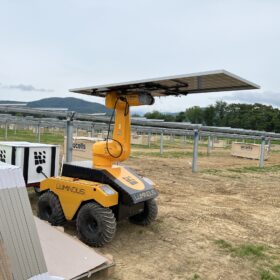The Northern Territory Government has granted final approval to Core Lithium to commence the development of its new lithium mine in the Top End. The Finniss Lithium Project is the first-ever lithium mine to be approved outside of Western Australia and is the first new mine of significant scale to be approved in the NT since 2013.
The proposed open-cut lithium mine is located along the Cox Peninsula Road, approximately 35 km west of Berry Springs and has a mineral resource of 9.63 million tonnes at 1.4% lithium oxide. The project is expected to yield approximately two million tonnes of lithium-bearing ore over the predicted three to four-year life of the mine as it provides around 200 jobs to local Territorians.
The government approval was the final regulatory hurdle required to commence site activities. “With this approval and continued NT Government backing, Core’s Finniss Lithium Project opens the door for the Northern Territory to be a high-quality supplier of lithium to the growing global electric vehicle market and play a critical role in supporting the world’s response to reducing emissions and managing climate change risk,” Core Lithium Managing Director Stephen Biggins said.
Core is aiming to complete offtake arrangements and have the Finniss Lithium Project construction-ready in 2020 ahead of sourcing debt and equity to achieve financial close. The project proponents argue that the Finnis Lithium Project has arguably the best-supporting logistics chain to markets in Asia of any Australian lithium project. The Project lies within 25 km of the port, power station, gas, rail and one hour by sealed road to workforce accommodated in Darwin and importantly to Darwin Port – Australia’s nearest port to Asia.
“With project approvals now in place and mine-life likely to double or even triple as we update our Feasibility Study by mid-2020, Core’s Finniss Lithium Project is positioned at the front of the line of new global lithium supply as EV manufacturing recovers post-Covid-19,” Biggins said.
The Territory Labor Government said it is well-aware that local jobs and economic recovery have never been more important. “The resources sector is going to play a huge role in our recovery from the Covid-19 crisis, and the milestone achieved by the Finniss Lithium Project is very good news for Territorians,” Northern Territory Minister for Primary Industry and Resources Paul Kirby said. “The first three years of this project are expected to inject over half a billion dollars into the NT economy and create around 200 jobs for Territorians within an hour of Darwin.”
Build it and they will come
The development of the Finniss Lithium Project has the potential to position the NT as a strategically important jurisdiction for the production, processing, and manufacturing of critical minerals to the global market. Contracts for 40% of the mine’s offtake are already in place and further sales agreements are being negotiated. The first production is expected approximately a year after project construction starts and Core is planning to export 175,000 tonnes per annum of high-quality lithium concentrate.
Globally, lithium oversupply has led to steep declines in prices as supply outpaced demand of the electro-mobility and energy storage sectors. According to the Australian Federal government’s most recent Resources and Energy Quarterly the lithium hydroxide price (delivered to China) eased by 18% in the December quarter, coming down to US$7,750/t, which was a 49% fall over the year 2019.
The report said prices should rise by 2025 to around US$10,400/t on the back of higher electric vehicle sales, with shortages possible from 2023. Global lithium consumption is projected to rise from 291,000t in 2019 to around 750,000t by 2025.
As for Australia, a strong rise in spodumene ore output in 2022 and 2023 is expected to follow the price induced slowdown as the demand for lithium and, in particular, lithium hydroxide rises. “Spodumene production in Australia has scaled back sharply in recent quarters, but capacity to refine lithium hydroxide is ramping up,” the report said.
This content is protected by copyright and may not be reused. If you want to cooperate with us and would like to reuse some of our content, please contact: editors@pv-magazine.com.









By submitting this form you agree to pv magazine using your data for the purposes of publishing your comment.
Your personal data will only be disclosed or otherwise transmitted to third parties for the purposes of spam filtering or if this is necessary for technical maintenance of the website. Any other transfer to third parties will not take place unless this is justified on the basis of applicable data protection regulations or if pv magazine is legally obliged to do so.
You may revoke this consent at any time with effect for the future, in which case your personal data will be deleted immediately. Otherwise, your data will be deleted if pv magazine has processed your request or the purpose of data storage is fulfilled.
Further information on data privacy can be found in our Data Protection Policy.